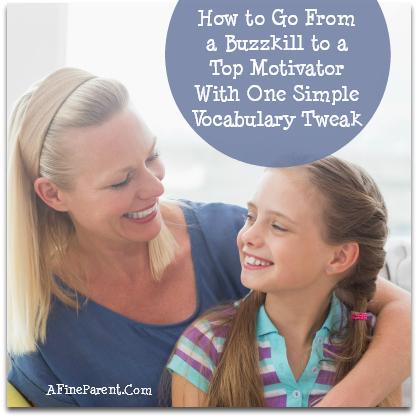 We’ve all had it said to us.
We’ve all had it said to us.
Your boss has said it:
“You did really awesome on the project, but your teamwork could use some improvement.”
Your mom has said it:
“I am proud of how successful you are, but when are you getting married?”
Your best friend has said it.
“You look really pretty in that dress, but you would look so good with your hair down!”
Do you even remember the first part of that sentence? The part that came before the ‘but’? You know, the compliment?
It turns out no one does. Especially not our kids.
But we’re supposed to give feedback, right? Isn’t that how we help our kids develop grit and resilience? Isn’t this how we help them build up and develop their talents?
How can we help them grow and achieve wonderful things if they think we don’t value them? If they believe they’ll never be good enough?
Don’t worry. There is a way.
 We’ll get back to it in a second. First, though, let’s explore…
We’ll get back to it in a second. First, though, let’s explore…
The Great Wall of ‘But’
 No one hears what comes before the word “but” when receiving praise or feedback. Using ‘but’ when giving feedback is like building a Great Wall between the good stuff and the negative stuff. It’s so large you can’t get back over the Wall to the good. You’re left wallowing in the bad.
No one hears what comes before the word “but” when receiving praise or feedback. Using ‘but’ when giving feedback is like building a Great Wall between the good stuff and the negative stuff. It’s so large you can’t get back over the Wall to the good. You’re left wallowing in the bad.
Top management consultants agree that “but” needs to butt out of feedback. In a Harvard Business Review article by Mark Goulston about giving feedback, he states, “When you say, ‘yes, but,’ they hear, “Everything up to now was just being polite and should be disregarded…”
“But” also makes people feel defensive. It’s definitely true for me! When I hear “but” my neck gets tight and my stomach braces for impact.
“You did a really good job on this article, but –“
Something bad is coming. Something that is going to hurt.
“… I think you should rewrite this paragraph.”
And there it is. I didn’t do a good job after all.
How often are we walling off our compliments with “but”? How often are we tainting the praise we give our kids with “buts” and “howevers”?
How can we change our feedback so that we aren’t unwittingly building our own Great Wall for our kids?
Use the ‘And’ Bridge Instead
 There is something powerful about the word “and.” It connects things and ideas. It lifts two ideas up and makes them of equal value. “But,” on the other hand, takes one idea and elevates its importance over the other.
There is something powerful about the word “and.” It connects things and ideas. It lifts two ideas up and makes them of equal value. “But,” on the other hand, takes one idea and elevates its importance over the other.
“You did a good job, but you can do better.”
“You did a good job and I see how you can do better.”
Saying “and” prevents the Great Wall from appearing and builds a bridge instead. It validates everything that was said – all that positive praise – and then adds to it. It tells our kids that there isn’t a catch, that we really mean what we say, that we believe in their talents and abilities, and that we believe they can grow.
At Pixar they call it “Plussing.” Saying “and” or “what if” helps directors and producers guide artists into building and improving on ideas without feeling judged.
For Example: “I really like how you drew this, and what if we shaded this tree with a bit more light green.”
It values the original thought and then encourages the artist to build and improve on it with feedback. It’s a technique of “this and that” instead of “this but that”. It’s how Pixar has had success after success.
I’ve been experimenting with this with my own children, and boy—it really works!
Especially for my older son. He really needs encouragement and needs to know that we recognize his talents. Yet, we still want him to grow. We don’t want him to rest on his laurels and stop trying.
Last week was a big test week for Evan in math. He’s doing really well in math. He’s actually progressing faster than the rest of his class. Because the concepts are coming easily, he tends to do the problems quickly and doesn’t bother to double-check them. And that leads to getting some wrong.
Sound familiar to anyone?
 He came to us with his test—18 out of 20. A great score, actually. He only missed two problems.
He came to us with his test—18 out of 20. A great score, actually. He only missed two problems.
But could he do better? Yes, he could.
It’s so tempting to say: “You did a good job, but if you had double-checked your work you could have gotten 100%.”
That ‘but’ in there leads to him feeling angry. “Nothing I do makes you happy!” he shouts.
Instead, I said, “You did really well on the test! And when you remember to slow down and check your work, you’re going to be fantastic.”
Try reading those out loud—I know that using ‘and’ instead of ‘but’ makes my whole body feel differently. I go from tensing up, for the blow, to staying relaxed and happy.
He also stays relaxed and happy. I get hugs and “Thanks, Mom!” instead of “Nothing is good enough!” More importantly, he hears that we are proud of him and he stays positive about trying harder.
This kind of “this and that” feedback is especially important for kids. Kids, especially when it comes to learning a new skill, need encouraging feedback in order to build confidence and then grit. The feedback after the ‘and’ can then help them build competency.
Lately, he’s trying really hard to improve in chess. He’s pretty uncertain about his ability to do well, so it’s important for us to point out something he did great at and then couple it with ‘and’ feedback.
The other day, a game ended with a loss for him. He was pretty devastated, but after I told him—“You had a great strategy with your bishop and rook, and once you are able to focus on the whole board a little more, you’ll see my attempts to flank you.”—he felt really positive and walked away knowing how he can probably beat me next time.
The ‘and’ bridge has completely changed his attitude toward receiving feedback. Instead of doing the opposite of what I suggest, he is actually listening to my feedback. An almost unheard-of event as the parent of a tween!
Building an ‘and’ bridge also builds a bridge between my son and me. It bridges our relationship and makes it stronger, a relationship that becomes even more tested (and at times tenuous) as he becomes a tween and soon a teenager.
And that is something pretty special.
 The 2-Minute Action Plan for Fine Parents
The 2-Minute Action Plan for Fine Parents
Our children need our guidance and feedback to grow into successful adults. For our quick contemplation today, think about or journal about the following:
- How often do you add the word ‘but’ after some positive feedback or praise?
- How is your child responding to your attempts to help them improve?
- When can you incorporate ‘and’ into your feedback?
The Ongoing Action Plan for Fine Parents
More than anything, our children want us to be proud of them. Including detailed positive feedback or praise with an ‘and’ bridge will help them recognize areas where they can improve. With practice, you will be able to realize when you are accidentally creating a wall and you’ll be able to turn it into an ‘and’ bridge instead. And before you know it, being a master motivator will be second nature!
I think this is a real great post.Really looking forward to read more. Great.
I just ran into this situation tonight when my son handed me his report card. I wish I could go back and conciously respond by showing him the pride I actually have in him.
It’s not too late! While you can’t go back in time you can always have the conversation again over dinner tonight. Use the ‘and’ and it will change how he feels. He will hear the pride you have and it will change his feelings in a positive way.